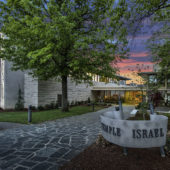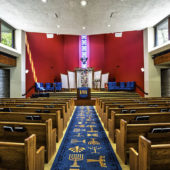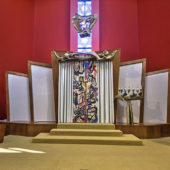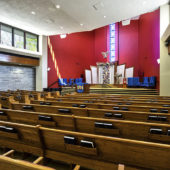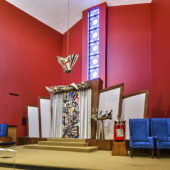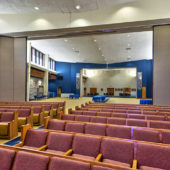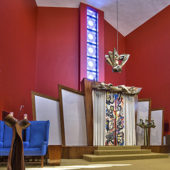A characteristically bold architectural design by Architect Percival Goodman
The original organizational meeting of the congregation was held December 8, 1914, at the Tulsa Chamber of Commerce. From 1914 through 1916 the congregation held High Holyday services in Tulsa’s Elk’s Club and the Ohio Building. In 1919 the first Temple was dedicated at 14th and Cheyenne (that building stands today). In 1932 the congregation established its second home at the comer of 16th and Rockford (now a playground).
Having outgrown the building at 16th and Rockford, architect Percival Goodman was commissioned to design a bold new synagogue south of Tulsa’s Utica Square Shopping Center, the then de-facto center of Tulsa. Like many of Percival Goodman’s designs, the form of the building was highly symbolic, not just a conglomeration of functional mass. Construction began in 1953. Facing the street on the building’s exterior there are two massive concrete tablets representing the biblical Pillar of Fire and Pillar of Cloud with the Ten Commandments inscribed. Inside, the reverse side of these massive tablets is painted red, forming the bimah area.
This third Temple was dedicated was dedicated in 1955. The congregation was led at that time by Rabbi Norbert L. Rosenthal. Cantor Harold Orbach became the ritual music leader and principal of the Religious School in 1956. In 1964 Harry Sebran became cantor and served actively until 1991, when Cantor Martin Levson brought a new style of music to the bimah with a guitar and camp-like energy.
After the Memorial Day flood of 1984, the facility underwent a major expansion, which included the Moe Gimp Early Learning Center, a premier early childhood education facility. The building was refurbished in 2004.
As of 2014, Rabbis Karen and Micah Citrin and Cantor Kari Siegel-Eglash lead the congregation as Reform Judaism continues to adapt to society’s changes while retaining Judaism’s rich traditions.
About the architect:
Percival Goodman (January 13, 1904 – October 11, 1989) was an American urban theorist and architect who designed more than 50 synagogues between 1948 and 1983. He has been called the leading theorist of modern synagogue design, and the most prolific architect in Jewish history.
Percival Goodman was born in New York City to wealthy parents who were artists. His brother was the noted writer and sociologist Paul Goodman. In 1925, Percival Goodman received the Society of Beaux-Arts Architects Paris Prize which sent him to the Ecole des Beaux-Arts in Paris, France for architectural training.
Goodman called himself “an agnostic who was converted by Hitler”, and after World War II he became more interested in Jewish architecture. At a 1947 conference of the Reform Jewish movement, the Union of American Hebrew Congregations, Goodman advocated the use of modern architecture for new Jewish buildings, rather than following the models of older churches and synagogues. He quickly began to receive commissions.


